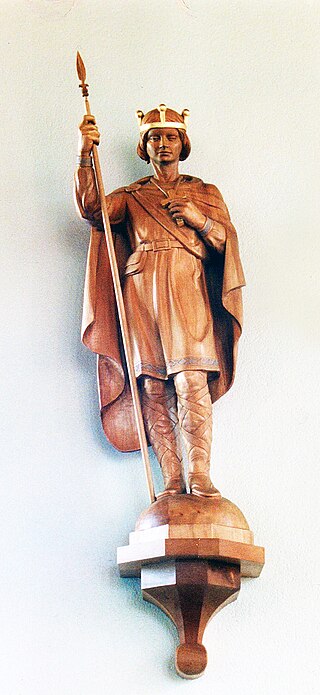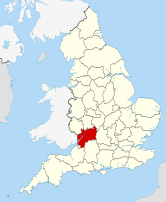
Sherborne Abbey, otherwise the Abbey Church of St. Mary the Virgin, is a Church of England church in Sherborne in the English county of Dorset. It has been a Saxon cathedral (705–1075), a Benedictine abbey church (998–1539), and since 1539, a parish church.

Buckfast Abbey forms part of an active Benedictine monastery at Buckfast, near Buckfastleigh, Devon, England. Buckfast first became home to an abbey in 1018. The first Benedictine abbey was followed by a Savignac, later Cistercian, abbey constructed on the site of the current abbey in 1134. The monastery was surrendered for dissolution in 1539, with the monastic buildings stripped and left as ruins, before being demolished. The former abbey site was used as a quarry, and later became home to a Gothic mansion house.

Pershore Abbey, at Pershore in Worcestershire, was an Anglo-Saxon abbey and is now an Anglican parish church, the Church of the Holy Cross.

Coenwulf was the King of Mercia from December 796 until his death in 821. He was a descendant of King Pybba, who ruled Mercia in the early 7th century. He succeeded Ecgfrith, the son of Offa; Ecgfrith only reigned for five months, and Coenwulf ascended the throne in the same year that Offa died. In the early years of Coenwulf's reign he had to deal with a revolt in Kent, which had been under Offa's control. Eadberht Præn returned from exile in Francia to claim the Kentish throne, and Coenwulf was forced to wait for papal support before he could intervene. When Pope Leo III agreed to anathematise Eadberht, Coenwulf invaded and retook the kingdom; Eadberht was taken prisoner, was blinded, and had his hands cut off. Coenwulf also appears to have lost control of the kingdom of East Anglia during the early part of his reign, as an independent coinage appears under King Eadwald. Coenwulf's coinage reappears in 805, indicating that the kingdom was again under Mercian control. Several campaigns of Coenwulf's against the Welsh are recorded, but only one conflict with Northumbria, in 801, though it is likely that Coenwulf continued to support the opponents of the Northumbrian king Eardwulf.

Hailes Abbey is a former Cistercian abbey, in the small village of Hailes, two miles northeast of Winchcombe, Gloucestershire, England. It was founded in 1246 as a daughter establishment of Beaulieu Abbey. The abbey was dissolved by Henry VIII in 1539. Little remains of the abbey. It is a Grade I listed building and a scheduled monument.

Winchcombe is a market town and civil parish in the Borough of Tewkesbury in the county of Gloucestershire, England, it is 6 miles (10 km) north-east of Cheltenham. The population was recorded as 4,538 in the 2011 census and estimated at 5,347 in 2019. The town is located in the Cotswolds and has many features and buildings dating back to medieval times. In 2021 it was the primary strike site of the eponymous Winchcombe meteorite.

Snowshill Manor is a National Trust property located in the village of Snowshill, Gloucestershire, United Kingdom. It is a sixteenth-century country house, best known for its twentieth-century owner, Charles Paget Wade, an eccentric who amassed an enormous collection of objects that interested him. He gave the property to the National Trust in 1951, and his collection is still housed there.

Saint Kenelm was an Anglo-Saxon saint, venerated throughout medieval England, and mentioned in the Canterbury Tales. William of Malmesbury, writing in the 12th century, recounted that "there was no place in England to which more pilgrims travelled than to Winchcombe on Kenelm's feast day".

The Abbey of Bury St Edmunds was once among the richest Benedictine monasteries in England, until its dissolution in 1539. It is in the town that grew up around it, Bury St Edmunds in the county of Suffolk, England. It was a centre of pilgrimage as the burial place of the Anglo-Saxon martyr-king Saint Edmund, killed by the Great Heathen Army of Danes in 869. The ruins of the abbey church and most other buildings are merely rubble cores, but two very large medieval gatehouses survive, as well as two secondary medieval churches built within the abbey complex.

Downside Abbey is a Benedictine monastery in England and the senior community of the English Benedictine Congregation. Until 2019, the community had close links with Downside School, for the education of children aged eleven to eighteen. Both the abbey and the school are at Stratton-on-the-Fosse, between Westfield and Shepton Mallet in Somerset, South West England. In 2020, the monastic community announced that it would move away from the present monastery and seek a new place to live. In October 2021, the monastic community further announced that as part of their transition they would move in Spring of 2022 to the temporary accommodation of "Southgate House, in the grounds of Buckfast Abbey, Devon, where we will live as the Community of St Gregory the Great". As of 2020, the monastic community of Downside Abbey was home to fifteen monks.

Abingdon Abbey was a Benedictine monastery in Abingdon-on-Thames in the modern county of Oxfordshire in the United Kingdom. Situated near to the River Thames, it was founded in c.675 AD and was dedicated to Mary, mother of Jesus. It was disestablished in 1538 during the dissolution of the monasteries. A few physical remnants of the Abbey buildings survive within Abingdon-on-Thames.

Bledington is a village and civil parish in the Cotswold district of Gloucestershire, England, about four miles southeast of Stow-on-the-Wold and six miles southwest of Chipping Norton. The population of the civil parish in 2014 was estimated to be 490.

Wulfred was an Anglo-Saxon Archbishop of Canterbury in medieval England. Nothing is known of his life prior to 803, when he attended a church council, but he was probably a nobleman from Middlesex. He was elected archbishop in 805 and spent his time in office reforming the clergy of his cathedral. He also quarrelled with two consecutive Mercian kings – Coenwulf and Ceolwulf – over whether laymen or clergy should control monasteries. At one point, Wulfred travelled to Rome to consult with the papacy and was deposed from office for a number of years over the issue. After Coenwulf's death, relations were somewhat better with the new king Ceolwulf, but improved much more after Ceolwulf's subsequent deposition. The dispute about control of the monasteries was not fully settled until 838, after Wulfred's death. Wulfred was the first archbishop to place his portrait on the coinage he struck.
Cwenthryth was a daughter of King Coenwul of Mercia. In 811 she witnessed a charter of her father as filia regis. She was abbess of Winchcombe Minster, Reculver and Minster in Thanet, which she inherited from her father. She also inherited a dispute with Wulfred, Archbishop of Canterbury, over control of Reculver and Minster in Thanet. Coenwulf died in 821 and in 825 Wulfred launched a lawsuit to force her to submit to him and by 827 he had gained control over the properties. She is not recorded after that year.

St John's Abbey, also called Colchester Abbey, was a Benedictine monastic institution in Colchester, Essex, founded in 1095. It was dissolved in 1539. Most of the abbey buildings were subsequently demolished to construct a large private house on the site, which was itself destroyed in fighting during the 1648 siege of Colchester. The only substantial remnant is the elaborate gatehouse, while the foundations of the abbey church were only rediscovered in 2010.

Hyde Abbey was a medieval Benedictine monastery just outside the walls of Winchester, Hampshire, England. It was dissolved and demolished in 1538 following various acts passed under King Henry VIII to dissolve monasteries and abbeys. The Abbey was once known to have housed the remains of King Alfred the Great, his son, King Edward the Elder, and his wife, Ealhswith. Following its dissolution these remains were lost; however, excavations of the Abbey and the surrounding area continue.

Prinknash Abbey is a Roman Catholic monastery in the Vale of Gloucester in the Diocese of Clifton, near the village of Cranham. It belongs to the English Province of the Subiaco Cassinese Congregation, which is itself part of the worldwide Benedictine Confederation. It is noted for its manufacturing of incense.

Eadnoth the Younger or Eadnoth I was a medieval monk and prelate, successively Abbot of Ramsey and Bishop of Dorchester. From a prominent family of priests in the Fens, he was related to Oswald, Bishop of Worcester, Archbishop of York and founder of Ramsey Abbey. Following in the footsteps of his illustrious kinsman, he initially became a monk at Worcester. He is found at Ramsey supervising construction works in the 980s, and around 992 actually became Abbot of Ramsey. As abbot, he founded two daughter houses in what is now Cambridgeshire, namely, a monastery at St Ives and a nunnery at Chatteris. At some point between 1007 and 1009, he became Bishop of Dorchester, a see that encompassed much of the eastern Danelaw. He died at the Battle of Assandun in 1016, fighting Cnut the Great.

The Abbey Church of Saint Peter and Saint Paul, Monkwearmouth–Jarrow, known simply as Monkwearmouth–Jarrow Abbey, was a Benedictine double monastery in the Kingdom of Northumbria, England.

St Paul's Church, Jarrow, is a Church of England parish church in the Parish of Jarrow and Simonside, on the south bank of the River Tyne in northern England. It was founded in 681 as a part of the Monkwearmouth–Jarrow Abbey. Most of the church is later, but the chancel is the remains of a free-standing chapel of the original monastery. Above the chancel arch is a dedication stone dating to 23 April 685, making this one of, if not the oldest, church dedication stones in England. The Church was dedicated to St Paul by King Ecgfrith and Abbot Ceolfrith. The priest and scholar Bede spent most of his life at the monastery and almost certainly worshipped in the oldest part of the church.






















